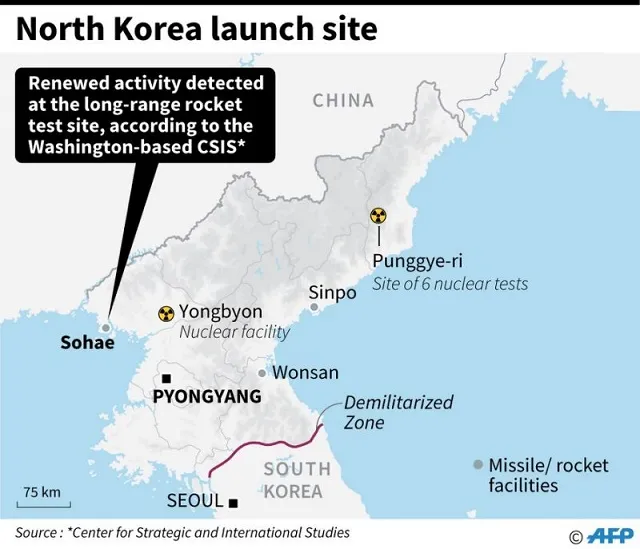Điều này làm gợi lên suy nghĩ rằng Triều Tiên đang nhanh chóng tái xây dựng cơ sở để phục vụ thử nghiệm tên lửa sau thất bại của cuộc gặp thượng đỉnh thứ hai với Mỹ tại Hà Nội.

Bản đồ vị trí bãi phóng tên lửa Sohae. Ảnh: AFP
Trung tâm Nghiên cứu Chiến lược và quốc tế có trụ sở tại Washington (CSIS) tiết lộ các hoạt động hiển thị “rõ ràng” tại dàn thử nghiệm động cơ tên lửa theo chiều thẳng đứng và kết cấu chuyển tên lửa vào đường ray lên bệ phóng tại Trạm phóng vệ tinh Sohae - cơ sở mà Bình Nhưỡng phóng vệ tinh trong năm 2012 và 2016.
Sohae cũng là địa điểm mà Bình Nhưỡng đã sử dụng để thử nghiệm một số động cơ tên lửa mặt đất.
Các vụ phóng vệ tinh đã bị cộng đồng quốc tế lên án và cho đây là các vụ thử tên lửa đạn đạo trá hình.
Việc bãi thử hoạt động trở lại đã được ghi nhận chỉ hai ngày sau khi kết thúc hội nghị thượng đỉnh giữa Tổng thống Donald Trump và Chủ tịch Kim Jong Un mà không đi đến kết luận. Điều này cũng chứng tỏ sự kiên quyết của Triều Tiên khi đối mặt với lời từ chối giảm nhẹ lệnh trừng phạt từ phía Mỹ, các chuyên gia nghiên cứu của CSIS cho biết.
Cơ sở phóng thử này đã đóng cửa từ tháng 8/2018, nên những hình ảnh chứng tỏ nơi đây đang hoạt động thể hiện đây là hành động có chủ ý và có mục đích.
Tuy nhiên, theo giám đốc dự án “38 North” Joel Wit thì bằng chứng này không hẳn cho thấy liên quan đến việc chuẩn bị cho một cuộc thử nghiệm ICBM vì hoạt động này đòi hỏi một loạt hoạt động nhưng không thấy hiển thị trong hình ảnh vệ tinh.
Triều Tiên phóng thành công tên lửa hạt nhân đầu tiên vào năm 2006 và sau đó là một loạt các vụ phóng thử ICBM đều diễn ra tốt đẹp.
Đến năm 2017, quốc gia này tuyên bố đã có khả năng phóng được tên lửa mang đầu đạn hạt nhân vươn xa đến tận bờ biển phía Đông nước Mỹ. Cũng trong năm đó, Triều Tiên bắt đầu nhận một loạt lệnh cấm vận từ Hội đồng bảo an Liên Hợp Quốc với mục đích phản đối chương trình hạt nhân của nước này.
Pyongyang 'rebuilding' main satellite launch site, photos show
(AFP) - Activity has been detected at a North Korean long-range rocket site suggesting Pyongyang may be pursuing the "rapid rebuilding" of a test facility after the collapse of the Hanoi summit, according to analysis of satellite imagery from a US think tank.
The Washington-based Center for Strategic and International Studies (CSIS) says activity is "evident" at the vertical engine test stand and the launch pad’s rail-mounted rocket transfer structure at the Sohae Satellite Launching Station -- the facility from which Pyongyang launched satellites in 2012 and 2016.
Sohae is also the site Pyongyang used as a test stand to fire some of its rocket engines on the ground.
The satellite launches were condemned by the international community and widely viewed as disguised ballistic missile tests.
The renewed activity was recorded two days after the Hanoi Summit between US President Donald Trump and North Korea's Kim Jong Un -- which ended early without an agreement -- and may "demonstrate resolve in the face of US rejection" of the North's request for sanctions relief, the CSIS researchers said.
"This facility had been dormant since August 2018, indicating the current activity is deliberate and purposeful."
But Joel Wit, the director of the respected Washington-based 38 North project cautioned that the evidence was not necessarily "consistent with preparations for an ICBM test".
"Aside from the fact that DPRK has never tested an ICBM from Sohae - it's a space vehicle launch site - preparation for any launch would require a wide range of activities not observed in the imagery."
Impoverished and isolated North Korea conducted its first successful nuclear test in 2006 followed by a string of increasingly successful ICBM launches.
In 2017, it claimed it had become a nuclear state, capable of fitting a viable nuclear weapon on an ICBM that could reach as far as the United States' eastern seaboard.
In the same year, the UN Security Council banned the North's main exports -- coal and other mineral resources, fisheries and textile products -- to cut off its access to hard currency in response to Pyongyang's pursuit of nuclear arms and ballistic missiles.
At their groundbreaking first summit in Singapore last year, Kim and Trump produced a vague statement on the "denuclearisation of the Korean peninsula".
There were high expectations for Kim and Trump's second meeting in Hanoi, but no agreement was reached. Despite the stalemate in Vietnam, however, both sides said they were open to further talks.
A third summit has not been scheduled.

